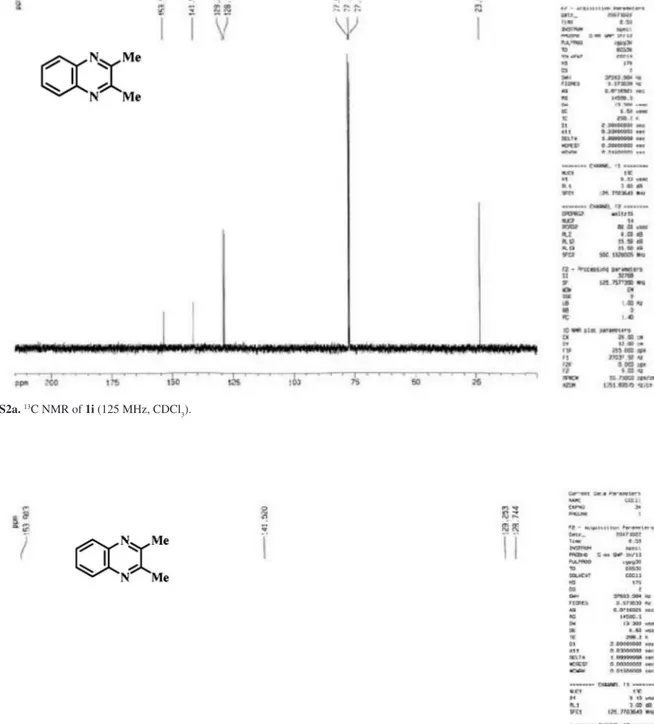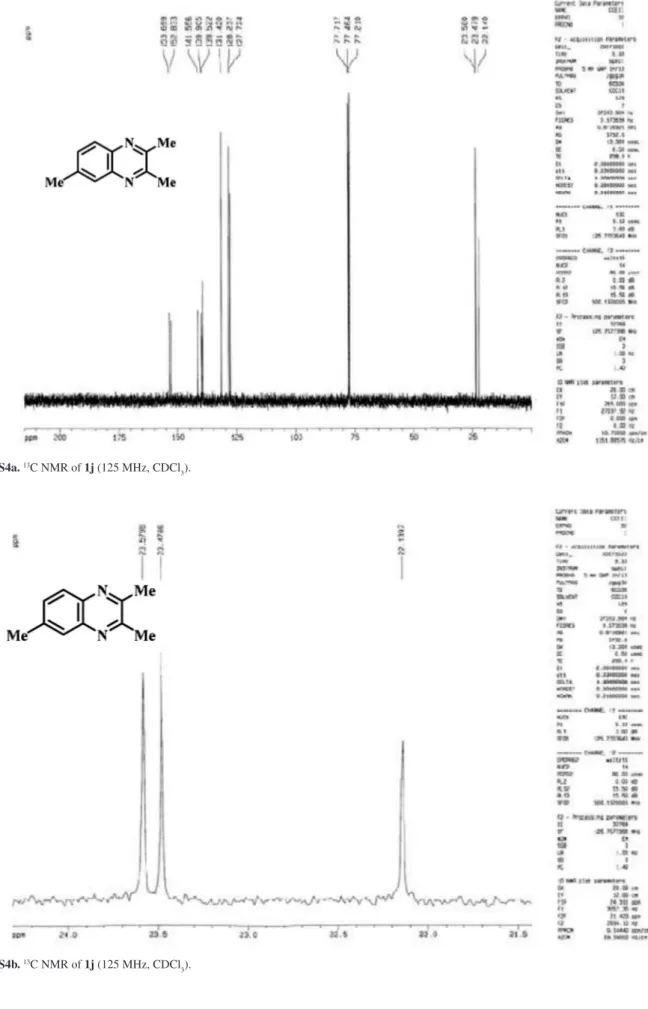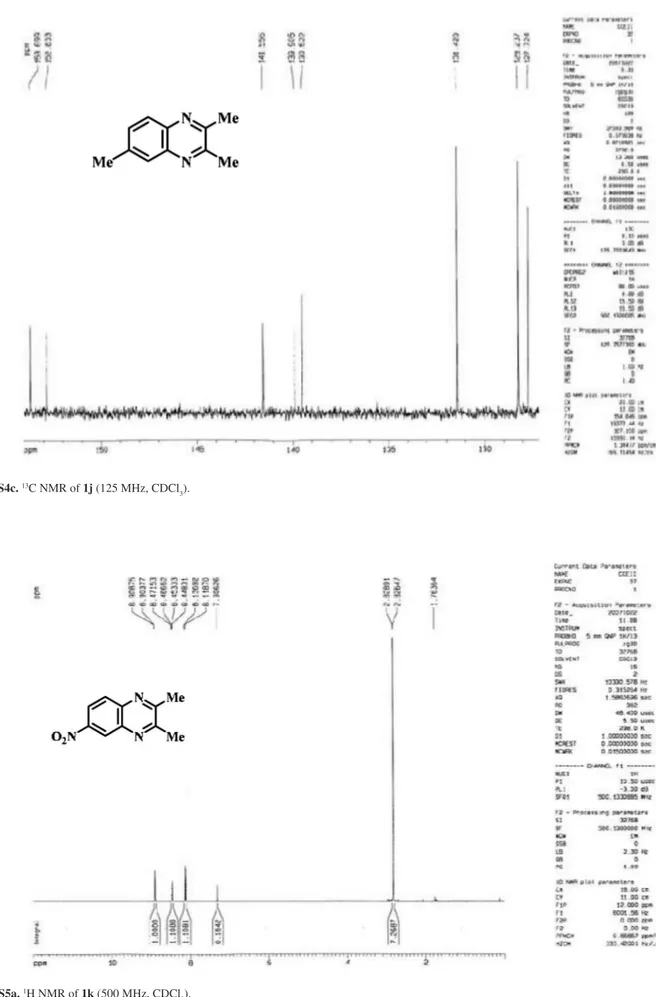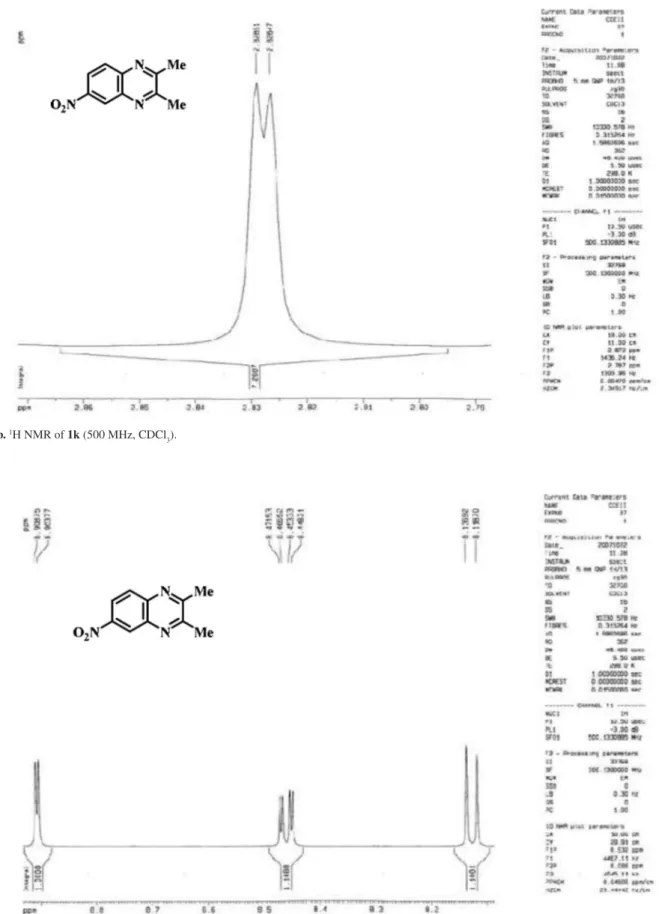S
ho
rt
R
e
p
o
rt
J. Braz. Chem. Soc., Vol. 19, No. 8, 1646-1652, 2008. Printed in Brazil - ©2008 Sociedade Brasileira de Química 0103 - 5053 $6.00+0.00
*e-mail: darabi@ccerci.ac.ir; r_darabi@yahoo.com
NH
4Cl-CH
3OH: an Efficient, Acid- and Metal-Free Catalyst System
for the Synthesis of Quinoxalines
Hossein Reza Darabi,* Fatemeh Tahoori, Kioumars Aghapoor, Fatemeh Taala and Farshid Mohsenzadeh
Chemistry & Chemical Engineering Research Center of Iran, Pajoohesh Blvd., km 17, Karaj Hwy, Tehran 14968-13151, Iran
A condensação direta de benzeno-1,2-diaminas (4-R-Ph-(NH2)2, onde R = H, Me, Cl e NO2) e 1,2-dicarbonil (R’-CO-CO-R’, onde R’ = Ph, 4-MeO-Ph e Me) foi realizada com excelentes rendimentos (95-100%) usando (NH4Cl-CH3OH) como sistema catalítico brando, eficiente, de boa
relação custo-benefício, fácil obtenção, isento de ácido e de metal e ambientalmente amigável, a temperatura ambiente. O procedimento pode ser realizado para diversas quinoxalinas e a natureza do grupo funcional no anel aromático das 1,2-diaminas exerce uma forte influência no tempo e rendimento da reação. A eficiência da condensação pode ser regulada também pela quantidade de catalisador e tempo de reação.
The direct condensation of various benzene-1,2-diamines [4-R-Ph-(NH2)2, where R = H, Me, Cl and NO2] and 1,2-dicarbonyl compounds (R’-CO-CO-R’, where R’ = Ph, 4-MeO-Ph and Me) has been successfully achieved mostly in excellent yields (95-100%) using (NH4Cl-CH3OH) as
a mild, efficient, cost-effective, readily available, acid-free, metal-free and eco-friendly catalyst system at room temperature. The procedure can be performed for a broad scope of quinoxalines, however, the nature of the functional group on the aromatic ring of 1,2-diamine exerts a strong influence on the time and the reaction yield. The condensation efficiency could be further regulated by the amount of catalyst and reaction time.
Keywords: quinoxalines, ammonium chloride-methanol, eco-friendly catalyst system, room
temperature
Introduction
Among the various classes of nitrogen containing heterocyclic compounds, quinoxalines are important components of several pharmacologically active compounds associated with a wide spectrum of biological activities ranging from antihelmintic and anticancer to antimicrobial, antifungal, antidepressant, antibacterial and anti-inflammatory activities.1
Although rarely described in nature, synthetic quinoxaline ring is a part of a number of antibiotics which are known to inhibit the growth of Gram-positive bacteria and are also active against various transplantable tumors.2 Moreover, they are well known
for their application in dyes,3 efficient electroluminescent
materials,4 organic semiconductors,5 building blocks for the
synthesis of anion receptors,6 cavitands,7 dehydroannulenes8
and DNA cleaving agents.9
In general, these compounds could be achieved via the double condensation of arene-1,2-diamines with
1,2-dicarbonyl compounds in organic solvents for 2-12 h under refluxing conditions with 34-85% yields.10 From the
synthesis standpoint, the traditional processes generally require high reaction temperature, strong acidic media, and mostly long reaction time.
Recent heating procedures have been reported in the literature for the synthesis of quinoxaline derivatives, using microwave,11 classical12 or ball-mill heating.13 In
contrast, many improved methods have been reported for the synthesis of quinoxalines at room temperature using catalytic amount of variety of molecular iodine,14,15
acids,16,17 and metal precursors.18-20
In a particular case, Brønsted-acidic task-specific ionic liquids (TSILs) were used as mild and green catalysts for the synthesis of quinoxaline derivatives, while the catalyst is not commercially available and a further step for its preparation is required.21
Darabi et al. 1647 Vol. 19, No. 8, 2008
isolation procedures, colored products demanding further recrystalization, expensive and detrimental metal precursors, and procedures with limited activity, i.e. without being applicable to the entire family of quinoxaline derivatives. Due to these problems, the search for the new readily available and green catalysts is still being actively pursued.
The development of cost-effective and environmentally benign catalytic systems is one of the main themes of contemporary organic synthesis. Ammonium chloride (NH4Cl) is a very inexpensive, eco-friendly and easily available catalyst. It has been reported as catalyst for synthesis of various organic compounds. It has effectively promoted Ugi four-component reactions22 and
four-component synthesis of pyrrolo[3,4-b]pyridinones.23
Moreover NH4Cl is effectively used as catalyst for aliphatic Claisen rearrangement,24 reduction of azo compounds to
their corresponding hydrazines,25 reduction of nitrophenols
in aqueous media26 and under ultrasound,27 reductive
cleavage of azo compounds,28 Biginelli synthesis of
3,4-dihydropyrimidinones,29 the one-pot synthesis of
diindolylmethanes,30 and the thia-Michael addition
reaction.31
The aim of this study is to utilize an eco-friendly NH4Cl–CH3OH system for the synthesis of quinoxaline derivatives at ambient temperature using ammonium chloride as an acid- and metal-free catalyst and methanol as the benign reaction medium in medicinal chemistry.32
Results and Discussion
In continuation of our interest on the development of efficient, practical and eco-friendly procedures for
the synthesis of condensed benzo[N,N]-heterocyclic compounds,33-35 we herein wish to introduce NH
4Cl-CH3OH
as a mild and effective catalyst system for the synthesis of quinoxaline derivatives. In general, this method affords the products in excellent yields and avoids the problems associated with catalyst cost, handling and safety.
We first studied a reaction between benzene-1,2-diamine and benzil by screening the reaction conditions. In order to determine the optimum conditions, we started by examining the influence of the reaction time and the solvent effect at room temperature (Table 1). After screening different solvents, it was found that NH4Cl-catalyzed synthesis of quinoxaline 1a is not only faster, but also results in excellent yields in MeOH than in other solvents (Table 1).
The effect of the amounts of NH4Cl on the yield of condensation reaction in MeOH was then explored using the same model reaction. As shown in Table 2, the various amounts of NH4Cl gave quantitative yield of product while the times for the completion of the reaction are within 7-36 min (Table 2, entries 1-4).
According to literature,10,33,36 the electron-withdrawing
groups on the aromatic ring of arene-1,2-diamines have negative influence on the reaction yield. This fact led us to investigate on the molar ratio of the catalyst to 4-chlorobenzene-1,2-diamine in order to develop reliable results.
The results of the reaction between 4-chlorobenzene-1,2-diamine and benzil are shown in Table 3. The increased loading of the catalyst from 5 to 50 mol% at an agreed time (1 h) clearly showed that the higher amount of the catalyst increased the yield of 1d noticeably (Table 3, entries 1-4). It appeared that a 50 mol% of NH4Cl in MeOH is the suitable choice for the general reaction.
Table 1. Synthesis of 2,3-diphenylquinoxaline (1a) in the presence of a catalytic amount of NH4Cl (10 mol%) in various solvents
Entry T / ºC time Solvent Isolated Yield / (%)
1 25 20 min CH3OH 100
2 25 1 h CH3CH2OH 92
3 25 3 h H2O 75
4 25 3 h C6H14 65
5 25 3 h CH2Cl2 62
6 25 3 h ClCH2CH2Cl 30
NH4Cl-CH3OH: an Efficient, Acid- and Metal-Free Catalyst System J. Braz. Chem. Soc.
1648
These excellent results led us to expand the generality of this catalyst to various substrates. We examined the reaction under optimized conditions and the results are summarized in Table 4. All of the products were characterized by 1H
NMR, 13C NMR, and MS spectral analysis.
As shown in Table 4, a series of arene-1,2-diamines reacted with various 1,2-dicarbonyls at room temperature smoothly to afford a wide range of quinoxaline derivatives, mostly in excellent yields. The results show that the nature of the functional group on the aromatic ring of the substrate exerted a strong influence on the time and the reaction yield. In general, when R on benzene-1,2-diamine represents the electron-withdrawing groups such as chloro (Table 4, entries d, h, l) and nitro groups (Table 4, entries c, g, k), longer reaction time is required. The existence of electron-donating substituent R’ such as methoxy on 1,2-dicarbonyls has also negative influence on the reaction rate (Table 4, entries e-h). Accordingly, it is expected that a reaction between 4-nitrobenzene-1,2-diamine and 4,4’-dimethoxy-benzil should give the low yield of product 1g (Table 4, entry g). Use of 200 mol% of NH4Cl, however, gave an improved yield of 1g after 4 h reaction at room temperature.
Our findings reflect the wide applicability and usefulness of the method (Table 4). Some previously reported data on reaction conditions and the yield of product for preparation of quinoxaline 1b were compared with our results (Table 5). As one can see our results show a very good comparability with previously reported data with regard to yields and reaction times.
The remarkable efficiency of NH4Cl–CH3OH system can be explained by a better synergetic effect of NH4Cl in its ionic form with MeOH. The proposed mechanism for NH4Cl-catalyzed synthesis of quinoxalines may be visualized to occur via a sequence of reactions as depicted in Scheme 1. Ammonium chloride may activate the carbonyl compounds by hydrogen bonding to promote the reaction via the nucleophilic attack of amines.30
Conclusions
In summary, we have highlighted the potential of NH4 Cl-CH3OH as a cheap, clean and non-toxic catalyst system for synthesis of quinoxalines from various 1,2-diketones and 1,2-diamines at ambient temperature. The attractive
Table 2. Optimization of the molar ratio of NH4Cl to benzene-1,2-diamine for preparing 2,3-diphenylquinoxaline(1a) at room temperature
Entry NH4Cl/% Solvent time/min Isolated Yield / (%)
1 50 mol MeOH 7 100
2 20 mol MeOH 16 100
3 10 mol MeOH 20 100
4 5 mol MeOH 36 100
Table 3. Optimization of the molar ratio of NH4Cl to 4-chlorobenzene-1,2-diamine for preparing 6-chloro-2,3-diphenylquinoxaline(1d) at room
temperature
Entry NH4Cl/% Solvent time / h Isolated Yield / (%)
1 50 mol MeOH 1 96
2 20 mol MeOH 1 72
3 10 mol MeOH 1 58
Darabi et al. 1649 Vol. 19, No. 8, 2008
features of this simple procedure are the mild reaction conditions, mostly excellent yields, acid-free, metal-free, readily available and environmentally friendly system, all of which make it a useful and attractive strategy for the preparation of various quinoxaline derivatives.
Experimental
Materials and methods
1H and 13C NMR spectra were recorded on a Bruker-500.
All NMR samples were run in CDCl3 and chemical shifts are expressed as ppm relative to internal Me4Si. Mass
spectra were obtained on a Fisons instrument. Column chromatography was carried out with the use of Merck Art. 7734 kieselgel 60, 70-230 mesh ASTM. Substrates are commercially available and used without further purification.
General procedure for the preparation of quinoxaline derivatives 1a-h
To a stirred solution of benzil or 4,4’-dimethoxy-benzil (1 mmol) in 5 mL methanol was added benzene-1,2-diamine (1.2 mmol) and ammonium chloride (50 mol%). The mixture was stirred at room temperature for an
Table 4. Synthesis of quinoxaline derivatives at room temperature using NH4Cl–CH3OH system
Entry R R’ Product 1 time Yield / (%)a,b
a H Ph 2,3-diphenylquinoxaline 7 min 100
b Me Ph 6-methyl-2,3-diphenylquinoxaline 5 min 100
c NO2 Ph 6-nitro-2,3-diphenylquinoxaline 4 h 25 (66)c (95)d
d Cl Ph 6-chloro-2,3-diphenylquinoxaline 1 h 96
e H 4-(MeO)-Ph 2,3-bis(4-methoxyphenyl)quinoxaline 1 h 95
f Me 4-(MeO)-Ph 6-methyl-2,3-bis(4-methoxyphenyl)quinoxaline 40 min 94
g NO2 4-(MeO)-Ph 6-nitro-2,3-bis(4-methoxyphenyl)quinoxaline 4 h 5 (20)c
h Cl 4-(MeO)-Ph 6-chloro-2,3-bis(4-methoxyphenyl)quinoxaline 2.5 h 96
i H Me 2,3-dimethylquinoxaline 5 min 100
j Me Me 6-methyl-2,3-dimethylquinoxaline 5 min 96
k NO2 Me 6-nitro-2,3-dimethylquinoxaline 4 h 97
l Cl Me 6-chloro-2,3-dimethylquinoxaline 35 min 97
aYields refer to those of pure isolated products characterized by 1H NMR, 13C NMR and MS spectral analyses. bThe reaction was carried out in the presence
of NH4Cl (50 mol%). cThe reaction was carried out in the presence of NH
4Cl (200 mol%) within 4 h.
dThe reaction was carried out in the presence of
NH4Cl (200 mol%) within 24 h.
Table 5. Synthesis of quinoxaline 1b at room temperature using different catalysts/solvents
Entry Catalyst Solvent time Yield / (%)a Ref.
1 Iodine (10 mol%) CH3CN 5 min 95 14
2 Iodine (10 mol%) DMSO 50 min 90 15
3 o-Iodoxybenzoic acid (1 mol%) CH3COOH 15 min 98 16
4 Montmorillonite K-10 (10% m/m) H2O 2.5 h 100 17
5 Cerium(IV) ammonium nitrate (5 mol%) H2O 10 min 90 18
6 Zn[(L)proline] (10 mol%) CH3COOH 5 min 96 19
7 Polyaniline-sulfate salt (5% m/m) ClCH2CH2Cl 15 min 92 36
8 Sulfamic acid (5 mol%) CH3OH 5 min 100 33
9 Ammonium chloride (50 mol%) CH3OH 5 min 100 Table 4
NH4Cl-CH3OH: an Efficient, Acid- and Metal-Free Catalyst System J. Braz. Chem. Soc.
1650
appropriate time (Table 4). After completion of the reaction (monitored by TLC), the reaction mixture was poured into water (20 mL) and the precipitated solid was collected by filtration and dried to afford the product 1. To obtain pure samples for analytical measurements, a silica gel column chromatography was performed. The eluent for all samples is ethyl acetate/hexane (3:7 v/v), except for 1d and 1h that is hexane/dichloromethane (1:10 v/v). The identification of the isolated products was generally performed by 1H NMR, 13C NMR and MS spectral analyses.
General procedure for the preparation of quinoxaline derivatives 1i- l
To a stirred solution of butane-2,3-dione (1.3 mmol) in 5 mL methanol was added benzene-1,2-diamine (1 mmol) and ammonium chloride (50 mol%). The mixture was stirred at room temperature for an appropriate time (Table 4). The progress was monitored by TLC. The reaction mixture was washed with water (20 mL) and extracted by CH2Cl2 (3 × 10 mL). The organic phase was evaporated under reduced pressure and the pure product 1i-l was obtained without any further purification.
Selected spectral data
2,3-dimethylquinoxaline (1i)
1H NMR (500 MHz, CDCl
3): d 2.78 (s, 6H), 7.70 (dd,
2H), 8.02 (dd, 2H); 13C NMR (125 MHz, CDCl
3): d 23.76,
128.7, 129.2, 141.5, 153.9; MS (EI), m/z (rel. intensity %) 158 (M+, 65), 116 (100), 76 (40), 50 (50).
6-methyl-2,3-dimethylquinoxaline (1j)
1H NMR (500 MHz, CDCl
3): d 2.60 (s, 3H), 2.75 (s,
6H), 7.53 (dd, 1H), 7.79 (s, 1H), 7.90 (d, 1H); 13C NMR
(125 MHz, CDCl3): d 22.1, 23.5, 23.6, 127.7, 128.2, 131.4, 139.5, 139.9, 141.6, 152.8, 153.7; MS (EI), m/z (rel. intensity %) 172 (M+, 100), 130 (90), 89 (45), 50 (20).
6-nitro-2,3-dimethylquinoxaline (1k)
1H NMR (500 MHz, CDCl
3): d 2.82 (s, 3H), 2.83 (s,
3H), 8.12 (d, 1H), 8.46 (dd, 1H), 8.90 (d, 1H); 13C NMR
(125 MHz, CDCl3): d 23.7, 23.9, 122.8, 125.3, 130.3, 140.4, 144.1, 147.6, 156.7, 157.6; MS (EI), m/z (rel. intensity %) 203 (M+, 100), 162 (30), 116 (50), 75 (15).
6-chloro-2,3-dimethylquinoxaline (1l)
1H NMR (500 MHz, CDCl
3): d 2.76 (s, 3H), 2.77 (s,
3H), 7.64 (dd, 1H), 7.93 (d, 1H), 8.00 (d, 1H); 13C NMR
(125 MHz, CDCl3): d 23.5, 23.6, 127.8, 130.0, 130.2, 134.8, 140.0, 141.8, 154.2, 154.9; MS (EI), m/z (rel. intensity %) 192 (M+, 70), 151 (100), 110 (60), 75 (65).
Supplementary Information
1H NMR and 13C NMR of the selected spectral
data mentioned above are available free of charge at http://jbcs.sbq.org.br, as PDF file.
Darabi et al. 1651 Vol. 19, No. 8, 2008
References
1. Hassan, S. Y.; Khattab, S. N.; Bekhit, A. A.; Amer, A.; Bioorg. Med. Chem. Lett.2006, 16, 1753; Perumal, R. V.; Mahesh, R.;
Bioorg. Med. Chem. Lett.2006, 16, 2769; Zhao, Z.; Leister, W. H.; Robinson, R. G.; Barnett, S. F.; Defeo-Jones, D.; Jones, R. E.; Hartman, G. D.; Huff, J. R.; Huber, H. E.; Duggan, M. E.; Lindsley, C. W.; Bioorg. Med. Chem. Lett.2005, 15, 905; Gomtsyan, A.; Bayburt, E. K.; Schmidt, R. G.; Zheng, G. Z.; Perner, R. J.; Didomenico, S.; Koenig, J. R.; Turner, S.; Jinkerson, T.; Drizin, I.; Hannick, S. M.; Macri, B. S.; McDonald, H. A.; Honore, P.; Wismer, C. T.; Marsh, K. C.; Wetter, J.; Stewart, K. D.; Oie, T.; Jarvis, M. F.; Surowy, C. S.; Faltynek, C. R.; Lee, C-H.; J. Med. Chem.2005, 48, 744; Jaso, A.; Zarranz, B.; Aldana, I.; Monge, A.; J. Med. Chem. 2005,
48, 2019; Seitz, L. E.; Suling, W. J.; Reynolds, R. C.; J. Med. Chem.2002, 45, 5604; Ali, M. M.; Ismail, M. M. F.; EI-Gaby, M. S. A.; Zahran, M. A.; Ammar, T. A.; Molecules2000, 5, 864.
2. Bailly, C.; Echepare, S.; Gago, F.; Waring, M.; Anti-Cancer Drug Des.1999, 14, 291; Dell, A.; Williams, D. H.; Morris, H. R.; Smith, G. A.; Feeney, J.; Roberts, G. C. K.; J. Am. Chem. Soc.1975, 97, 2497; Sato, S.; Shiratori, O.; Katagiri, K.; J. Antibiot.1967, 20, 270.
3. Sonawane, N. D.; Rangnekar, D. W.; J. Heterocycl. Chem.2002,
39, 303; Katoh, A.; Yoshida, T.; Ohkanda, J.; Heterocycles2000,
52, 911.
4. Justin Thomas, K. R.; Velusamy, M.; Lin, J. T.; Chuen, C-H.; Tao, Y-T.; Chem. Mater.2005, 17, 1860.
5. Dailey, S.; Feast, W. J.; Peace, R. J.; Sage, I. C.; Till, S.; Wood, E. L.; J. Mater. Chem.2001, 11, 2238; O’Brien, D.; Weaver, M. S.; Lidzey, D. G.; Bradley, D. D. C.; Appl. Phys. Lett.1996, 69, 881.
6. Sessler, J. L.; Maeda, H.; Mizuno, T.; Lynch, V. M.; Furuta, H.;
Chem. Commun.2002, 862.
7. Sessler, J. L.; Maeda, H.; Mizuno, T.; Lynch, V. M.; Furuta, H.;
J. Am. Chem. Soc.2002, 124, 13474; Castro, P. P.; Zhao, G.; Masangkay, G. A.; Hernandez, C.; Gutierrez-Tunstad, L. M.;
Org. Lett.2004, 6, 333.
8. Ott, S.; Faust, R.; Synlett2004, 1509.
9. Kazunobu, T.; Ryusuke, T.; Tomohiro, O.; Shuichi, M.; Chem. Commun. 2002, 212; Hegedus, L. S.; Greenberg, M. M.; Wendling, J. J. Bullock, J. P.; J. Org. Chem.2003, 68, 4179. 10. Brown, D. J. In Quinoxalines: SUPPLEMENT II, The Chemistry
of Heterocyclic Compounds, Taylor, E. C.; Wipf, P., eds.; John Wiley and Sons: New Jersey, 2004.
11. Villemin, D.; Martin, B.; Synth. Commun. 1995, 25, 2319; Juncai, F.; Yang, L.; Qinghua, M.; Bin, L.; Synth. Commun.
1998, 28, 193; Vázquez, E.; de la Hoz, A.; Elander, N.; Moreno, A.; Stone-Elander, S.; Heterocycles2001, 55, 109; Goswami, S.; Adak, A. K.; Tetrahedron Lett. 2002, 43, 8371; Zhao, Z.;
Wisnoski, D. D.; Wolkenberg, S. E.; Leister, W. H.; Wang, Y.; Lindsley, C. W.; Tetrahedron Lett. 2004, 45, 4873; Kim, S. Y.; Park, K. H.; Chung, Y. K.; Chem. Commun. 2005, 1321; Kidwai, M.; Saxena, S.; Mohan, R.; J. Korean Chem. Soc.2005, 49, 288; Azizian, J.; Karimi, A. R.; Kazemizadeh, Z.; Mohammadi, A. A.; Mohammadizadeh, M. R.; Tetrahedron Lett. 2005, 46, 6155; Gris, J.; Glisoni, R.; Fabian, L.; Fernández, B.; Moglioni, A. G.
Tetrahedron Lett. 2008, 49, 1053.
12. Liu, J-H.; Wu, A-T.; Huang, M-H.; Wu, C-W.; Chung, W-S.;
J. Org. Chem. 2000,65, 3395.
13. Kaupp, G.; Naimi-Jamal, M. R.; Eur. J. Org. Chem. 2002, 1368.
14. More, S. V.; Sastry, M. N. V.; Wang, C-C.; Yao, C-F.; Tetrahedron Lett. 2005, 46, 6345.
15. Bhosale, R. S.; Sarda, S. R.; Ardhapure, S. S.; Jadhav, W. N.; Bhusare, S. R.; Pawar, R. P.; Tetrahedron Lett. 2005, 46, 7183.
16. Heravi, M. M.; Bakhtiari, K.; Tehrani, M. H.; Javadi, N. M.; Oskooie, H. A.; Arkivoc 2006, xvi, 16.
17. Huang, T-K.; Wang, R.; Shi, L.; Lu, X-X.; Catal. Commun.
2008, 9, 1143.
18. More, S. V.; Sastry, M. N. V.; Yao, C-F.; Green Chem.2006, 8, 91.
19. Heravi, M. M.; Tehrani, M. H.; Bakhtiari, K.; Oskooie, H. A.;
Catal. Commun. 2007, 8, 1341.
20. Kumar, A.; Kumar, S.; Saxena, A.; De, A.; Mozumdar, S. ;
Catal. Commun.2008, 9, 778.
21. Dong, F.; Kai, G.; Zhenghao, F.; Xinli, Z.; Zuliang, L. ; Catal. Commun.2008, 9, 317.
22. Bonne, D.; Dekhane, M.; Zhu, J.; Org. Lett.2004, 6, 4771. 23. Janvier, P.; Sun, X.; Bienayme, H.; Zhu, J.; J. Am. Chem. Soc.
2002, 124, 11.
24. Ralls, J. W.; Lundin, R. E.; Bailley, G. F.; J. Org. Chem.1963,
28, 3521.
25. Sridhara, M. B.; Srinivasa, G. R.; Gowada, D. C.; J. Chem. Res., Synop.2004, 74.
26. Sridharan, V.; Karpagavalli, M.; Muthusubramanian, S.; Sivasubramanian, S.; Indian J. Chem., Sect. B: Org. Chem. Incl. Med. Chem. 2004, 43, 2243.
27. Basu, M. K.; Becker, F. F.; Banik, B. K.; Tetrahedron Lett. 2000,
41, 5603.
28. Sridahara, M. B.; Srinivasa, G. R.; Gowada, D.C.; Synth. Commun. 2004, 34, 1441.
29. Shaabani, A.; Bazgir, A.; Teimouri, F.; Tetrahedron Lett. 2003,
44, 857.
30. Azizian, J.; Teimouri, F.; Mohammadizadeh, M. R.; Catal. Commun. 2007, 8, 1117.
31. Chen, W. Y.; Shi, L.; Catal. Commun. 2008, 9, 1079. 32. According to the “solvent selection tool” implemented by
NH4Cl-CH3OH: an Efficient, Acid- and Metal-Free Catalyst System J. Braz. Chem. Soc.
1652
chemistry; Alfonsi, K.; Colberg, J.; Dunn, P. J.; Fevig, T.; Jennings, S.; Johnson, T. A.; Kleine, H. P.; Knight, C.; Nagy, M. A.; Perry, D. A.; Stefaniak, M.; Green Chem.2008, 10, 31. 33. Darabi, H. R.; Mohandessi, S.; Aghapoor, K.; Mohsenzadeh,
F.; Catal. Commun. 2007, 8, 389.
34. Mohsenzadeh, F.; Aghapoor, K.; Darabi, H. R.; J. Braz. Chem. Soc. 2007, 18, 297.
35. Aghapoor, K.; Darabi, H. R.; Mohsenzadeh, F.; Z. Naturforsch., B: Chem. Sci. 2005, 60, 901.
36. Srinivas, C.; Kumar, C. N. S. S. P.; Jayathirtha Rao, V.; Palaniappan, S.; J. Mol. Catal. A: Chem.2007, 265, 227.
Received: June 1, 2008
S
u
p
p
le
m
e
nta
ry
Inf
o
rm
a
ti
o
n
J. Braz. Chem. Soc., Vol. 19, No. 8, S1-S11, 2008. Printed in Brazil - ©2008 Sociedade Brasileira de Química 0103 - 5053 $6.00+0.00
*e-mail: darabi@ccerci.ac.ir; r_darabi@yahoo.com
NH
4Cl-CH
3OH: An Efficient, Acid- and Metal-Free Catalyst System for
the Synthesis of Quinoxalines
Hossein Reza Darabi,* Fatemeh Tahoori, Kioumars Aghapoor, Fatemeh Taala and Farshid Mohsenzadeh
Chemistry & Chemical Engineering Research Center of Iran, Pajoohesh Blvd., km 17, Karaj Hwy, Tehran 14968-13151, Iran
Figure S1b. 1H NMR of 1i (500 MHz, CDCl
3).
Figure S1a. 1H NMR of 1i (500 MHz, CDCl
NH4Cl-CH3OH: An Efficient, Acid- and Metal-Free Catalyst System J. Braz. Chem. Soc.
S2
Figure S2b. 13C NMR of 1i (125 MHz, CDCl
3).
Figure S2a. 13C NMR of 1i (125 MHz, CDCl
Darabi et al. S3 Vol. 19, No. 8, 2008
Figure S3b. 1H NMR of 1j (500 MHz, CDCl
3).
Figure S3a. 1H NMR of 1j (500 MHz, CDCl
NH4Cl-CH3OH: An Efficient, Acid- and Metal-Free Catalyst System J. Braz. Chem. Soc.
S4
Figure S4a. 13C NMR of 1j (125 MHz, CDCl
3).
Figure S4b. 13C NMR of 1j (125 MHz, CDCl
Darabi et al. S5 Vol. 19, No. 8, 2008
Figure S4c. 13C NMR of 1j (125 MHz, CDCl
3).
Figure S5a. 1H NMR of 1k (500 MHz, CDCl
NH4Cl-CH3OH: An Efficient, Acid- and Metal-Free Catalyst System J. Braz. Chem. Soc.
S6
Figure S5b. 1H NMR of 1k (500 MHz, CDCl
3).
Figure S5c. 1H NMR of 1k (500 MHz, CDCl
Darabi et al. S7 Vol. 19, No. 8, 2008
Figure S6a. 13C NMR of 1k (125 MHz, CDCl
3).
Figure S6b. 13C NMR of 1k (125 MHz, CDCl
NH4Cl-CH3OH: An Efficient, Acid- and Metal-Free Catalyst System J. Braz. Chem. Soc.
S8
Figure S6c. 13C NMR of 1k (125 MHz, CDCl
3).
Figure S7a. 1H NMR of 1l (500 MHz, CDCl
Darabi et al. S9 Vol. 19, No. 8, 2008
Figure S7c. 1H NMR of 1l (500 MHz, CDCl
3).
Figure S7b. 1H NMR of 1l (500 MHz, CDCl
NH4Cl-CH3OH: An Efficient, Acid- and Metal-Free Catalyst System J. Braz. Chem. Soc.
S10
Figure S8a. 13C NMR of 1l (125 MHz, CDCl
3).
Figure S8b. 13C NMR of 1l (125 MHz, CDCl
Darabi et al. S11 Vol. 19, No. 8, 2008
Figure S8c. 13C NMR of 1l (125 MHz, CDCl









